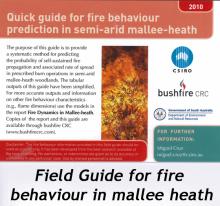Fire behaviour modelling in shrub and heath lands
Fire Behaviour Modelling

This project addressed the need to better understand the interactions between fire, fuel, weather and topography.
Factors include rate of spread, flame height, intensity and spotting for both wildfires and controlled prescribed fires. The research included experimentation and validation of fire behaviour models, documentation, training and the production and delivery of fire behaviour systems to end users.
Research work included field validation of the findings from Project Vesta results in south eastern fuels. Project Vesta was a comprehensive research project between CSIRO and Department of Environment and Conservation in Western Australia, investigating the behaviour of bushfires in different fuel ages and structures during dry summer conditions.
According to project leader Jim Gould of CSIRO:“As a result of this research we have developed a new bushfire spread model for summer wildfires that will provide the basis for a national fire behaviour prediction system for dry eucalypt forests.”
A new model for crown spread in pine plantations was developed out of observations of a plantation fire in Tumut, New South Wales.
Large scale experimental burning and the collection of fire behaviour information from at the Ngarkat Conservation Park in South Australia led a new guide for burning in mallee heath and scrubland, a vegetation type that covers large parts of southern Australia This output was led by Dr Miguel Cruz of CSIRO and followed up with field clinics and a handy field guide to assist fire managers.
This was well received by fire managers with one corresponding after the clinic: “It was a really interesting presentation and the field guide reference is a very valuable tool. We actually used it to determine if we had a 'go' or 'no go' burn day when we started our burning campaign and despite some staff believing fuel moistures would be too high we had sustained propagation due to reasonable wind strengths.”
A PhD project by Phil Lacy developed a field guide for the often difficult task of prescribed burning in young eucalypt plantations. A workshop and field trip for plantation industry staff reinforced these learnings in a hands-on way.
A study on how educational multi-media programs may improve the delivery of fire behaviour training was the focus of postgraduate student Annette Salter, at the University of Tasmania.
















